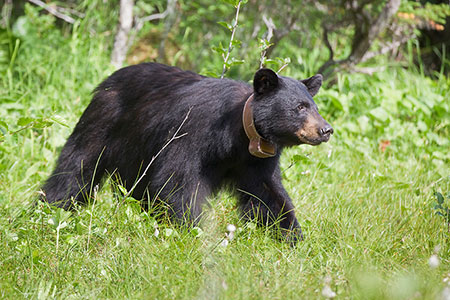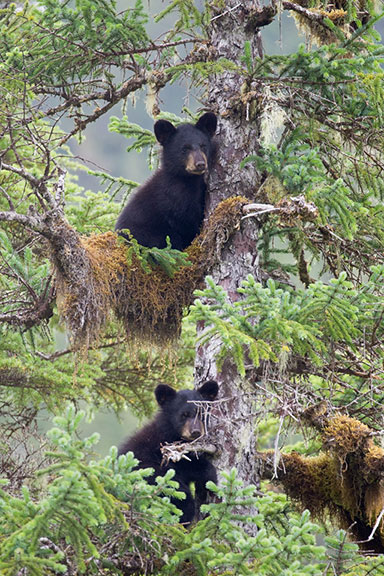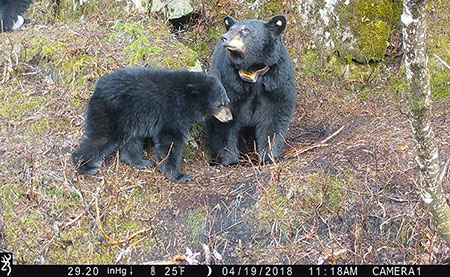Alaska Fish & Wildlife News
January 2019
Black Bear Research
In Prince William Sound

Tucked into crevices and caves on two islands in Prince William Sound, about four dozen black bears are hibernating wearing GPS collars. When they emerge in the spring of 2019, these collared animals will provide insights into how bears use their habitat in Prince William Sound – when and where they go, and how it varies between males and females.
Over the past three years, biologists Charlotte Westing of ADF&G and Milo Burcham of USFS have captured 96 different black bears on Esther and Knight Islands – including 25 bears this past summer. The captures themselves were a major accomplishment and provided a wealth of information for scientists and managers.
“We are very happy with how it went,” Burcham said. “The captures and collaring exceeded our expectations in the number of bears and our ability to get bears.”
The Cordova-based biologists are studying black bears in a particularly dynamic environment. Winters range from mild to extreme (a three-week storm in January 2012 dumped 18 feet of snow on Cordova, in a winter dubbed “the snowpocalypse.”). Also dynamic in terms of productivity – summer blueberry and salmonberry crops can be abundant to poor; and also in terms of human use of the region. The area is popular with hunters, and the annual harvest of black bears has trended from fewer than 100 to more than 500.
The project is a partnership between the U.S. Forest Service and the Alaska Department of Fish and Game. Milo Burcham is a wildlife biologist and leads the Chugach National Forest subsistence program in Cordova; Westing is a wildlife biologist with the Division of Wildlife Conservation for the North Gulf Coast-Prince William Sound area. They outlined some of the goals of the project: Can a boat-based trapping effort capture a representative sample of bears? Are bears using habitats that make them vulnerable to hunting or do they avoid theses habitats? Are males and female black bears using these habitats differently?
They’ve answered the first question – yes. Westing said the goal was to deploy about 50 GPS collars, and they accomplished that almost twice over in terms of capture success. She explained why they captured 96 bears and collared about half that number.
“We handled a lot of bears that were not the appropriate size to collar,” she said. “We have a huge slug of young animals moving through the population. The last few years have been good for cub production and retention. We can only collar animals that have substantially reached the size of their frame. We know they get fatter, but we don’t want them getting bigger and fatter and outgrowing their collar.”
Some of the bears will potentially be wearing the collars for three years. Westing added that every bear snared needs to be sedated or tranquilized before it can be freed, and while it may be too young and small to collar, it can provide valuable information.

“We have to drug them to get them out of the snare,” she said. “And with every bear we handle we take the full suite of samples: blood, tissue, and hair. We're looking at teeth, weight, and sex.”
Samples collected are archived, and provide opportunities for future studies – for example, a researcher could use a blood sample to look at diseases.
Snaring bears
Foot snares are an effective way to catch bears, and in July of 2018, biologists set up 13 snares on Esther Island. The snares are a bit more sophisticated than a simple loop in a cable and can be monitored remotely so biologists can detect when a set is triggered. Whether a foot snare is placed in a bucket mounted on a tree, or is on the ground in a bear trail, all are set with VHF trap transmitters that signal biologists when the snare is triggered.
“One of the major goals was to minimize the time in the snare, it’s stressful for the bear,” Burcham said. “We visited every trap site every day to visually check them, but we also had VHF transmitters at all the trapsites. A magnet is pulled off the snare and triggers the signal, which goes from a slow pulse rate to fast pulse rate.”
Each foot snare is assigned a different frequency, and a biologist can quickly scan the frequencies with a VHF radio receiver and check the pulse signal remotely through the day. That meant bears did not spend much time in the snare.
Processing
When the biologists got a positive signal, the four-person capture team was assembled. Packs were loaded with animal workup gear, capture drugs and a jab stick for injections, weighing gear (an aluminum pole for lifting the animal, a scale and cargo net) and collars. The team carried firearms as well.
“We’d approach from a distance and all get a look, and estimate its weight, then gauge the dose of drug needed based on estimated weight,” Burcham said. “When we are estimating the weight, they know we are there, and the animals are typically submissive, not aggressive. We try to minimize stress in every way we can, we remain calm, move slow, and once they are tranquilized we move away and let them calm down. It takes three to five minutes for the drugs to take effect.”
Technically the bears are not tranquilized but “chemically immobilized.” Fish and Game researchers developed a combination of two drugs that are quite effective in tandem, and one can be reversed when the processing session is over. Processing typically took less than 30 minutes.

Westing said in 2016, the first season of captures, she used a dart gun to administer the drug. She was unhappy with the performance for a variety of reasons, and partway through the 2017 season, she switched to the jab stick.
“In the second year a colleague from the Montana Department of Fish, Wildlife and Parks came up and volunteered, and he mentored me on the use of the jab stick,” she said. “It’s a lot of easier on the bear, very effective placing the injection right where you want, and I found I could get them down faster with less drug.”
In addition to taking samples and collaring, each bear was given an ear tag and weighed. The animal was lifted in a cargo net attached to the scale and pole, and the pole enabled the team to lift the bear off the ground and get an accurate weight.
One notable capture from work in the summer of 2018 was the recapture of Bear #01, the first capture of the entire project back in 2016. Her collar worked for a year and then quit transmitting in August 2017. Burcham and Westing attempted to catch her hibernating in her den and replace the collar in April 2018, but were unsuccessful. She was caught serendipitously this past summer in a foot snare near Esther Bay, on the very periphery of her home range and re-collared.
Size
Several mature males were close to 300 pounds, and the largest female was 275 pounds. Burcham said a 300-pound black bear in Prince William Sound is a really big bear.
Burcham said that black bears are smaller than people think. He added that it’s difficult to judge the weight of a bear, even for the biologists.
“Having trapped one hundred bears gave me an appreciation for how difficult it is to judge the size of a bear,” he said.
“Some are exceptionally well-furred,” Westing said. “We had one we thought was huge, we got up to her and she was just about 100 pounds. She was so fluffy she didn’t look lanky, and her ears didn’t look big.”
Westing said the bears were weighed mid-summer, and could pack on more weight as the summer progressed, especially in a summer with a good berry crop. However, 2018 was not a good year for berries in Prince William Sound or northern Southeast Alaska, and biologists suspect that influenced the bears’ movements over the summer.
GPS tracking and movement
The GPS device on the collar logs a waypoint every five hours, and every two days that batch of points is uploaded to a satellite and biologists can access the data. This has provided more than 34,000 location points so far, offering a good picture of each bear’s movements.
Bears have a home range, not a territory, and they know the resources available within their home range. A preliminary assessment of 13 female bears on Esther Island indicated a home range of 10 square kilometers from 2016 through 2017. In late July of 2018, six of these bears expanded their movements, four of them moving considerable distances.

“They went outside of where we’d seen them, some way outside, probably looking for food,” Burcham said.
People in coastal Alaska from Juneau to Cordova reported that the blueberry and salmon berry crops were poor. That’s not something that is formally measured and documented, but Westing wishes it was.
“It wasn’t quantified, it’s anecdotal,” she said. “I am an avid berry picker, and in the place I go to pick berries I could barely cover the bottom of the bucket in the time I could normally fill it half full or more. I expanded my area and I never found anything that was impressive. The salmon berries were late, compressed and not abundant; the blueberry crop was late and not abundant at all. And the ones that were there were little, hard, and withered, not plump, juicy, nice berries.”
Burcham said that could explain why there were so many bears in Cordova this summer.
“The bears were wandering and they were really attracted to the food sources they could find,” he said. “If they found a town with unsecured garbage – there you go. It was a huge issue in Cordova this year.”
“We had so many bear problems in town, the troopers had to shoot a bear in the harbor,” Westing said. “She was at least 12 years old, 175 pounds, and you wonder: has she been living in harmony with Cordova all these years and she just now came into town, or did she have a home range somewhere else, and she left it this year?”
Denning and Hibernation
On Nov. 15, the GPS collars went into a battery-saving mode, since the bears presumably would be denned up and not moving anyway. In this mode the waypoints are uploaded once every seven or eight days, but the connection often fails because of the bears’ location underground.
“Once they den we typically don’t get any locations for several months,” Burcham said. “We seldom get an idea where the den is from locations before they go in. But when they emerge in spring, they spend a week to two weeks at the entrance to the den. We get a good idea where the den is. There is also the VHF transmission, and we can use that to locate denning bears.”
The VHF transmitter in each collar is used to locate the collar when it comes off. The first collars that were deployed in 2016 are programmed to release in October of 2019, the rest will release between 2020 and 2021. Westing and Burcham visited some dens in the past two winters, to set up trail cameras and replace some collars. Westing said right now, two collars have quit working and may be replaced this coming winter.

“We’re doing a bit of den work, and putting some cameras outside dens to see how many cubs the bears emerge with,” Burcham said. “In contrast to all the dens on Prince of Wales that are in upturned root wads or trees, none of the dens were associated with trees. All of them are in caves or under boulders. This is all a granitic landscape, and lacks the large trees found in Southeast Alaska.”
Several of the motion-triggered trail cameras were in place over the course of the summer. Burcham said they’ve documented bears visiting den sites during the summer months. In one instance, a goshawk landed near the entrance and seemed curious about the site.
“It’s an aside, but it’s interesting,” he said. “It’s basically just a hole, but river otters go in and out, marten go in and out, and different bears, not just the bears that denned there, investigate the dens throughout the summer.”
In one odd turn of events in the spring of 2018, a trail camera documented illegal hunting activity, where a bear and her cubs were killed at a den.
Over the past two years, five collared bears were legally harvested by hunters. One bear died of unknown causes – in December of 2017 the signal changed to what is known as “mortality mode.” Researchers located the carcass in July and were able to retrieve the collar.
With the capture sessions completed, the researchers will be collecting location data on the 44 bears wearing active collars for the next one to three years. Westing said they are now switching to a more data-focused stage of the project.
“We’ve invested a huge amount of time and energy and were really happy with what we’ve found so far,” she said.
Riley Woodford is the editor of Alaska Fish and Wildlife News and the producer of the Sounds Wild! radio program.
November 2016 article about this project: Collared Bears Provide Insights
Bear Research on Prince of Wales Island
Nesting Bears: Bear Dens on Prince of Wales Island
Black Bear Species Profile
Subscribe to be notified about new issues
Receive a monthly notice about new issues and articles.
